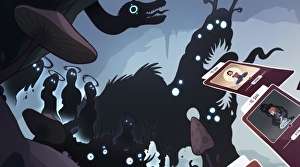
Bertie: It’s the monsters that do it for me. They are manifestations of phobias, and even though I am lucky enough to not have any phobias (that I know of), they unsettle me. Take the Tokophobia monster: it’s based around a fear of childbirth, and here it’s depicted by a silhouetted pregnant woman on her knees, whose bulging stomach morphs into an angry child when it attacks. That’s freaky, right?
Or there’s the Haptophobia monster, which I think ought to be Haphephobia because it’s based around a phobia of touching. Here, it’s a creature made of many hands that all reach out and grab at you when it attacks, and it’s grotesque.
There are others but I don’t want to spoil them. But it’s the way they’re brought to life, the way they look and behave, moving as if made for a vintage cartoon, in a kind of flick-book animated way, which speaks to a kind of quality in Neurodeck which elevates it. That, hand-in-hand with the game’s focus on mental health, and cards themed around ways to deal with phobias, and keeping a mind calm and positive, are what makes Neurodeck more than another game moulded around a Slay the Spire frame. They’re its difference. And they manage a kind of relevance and connection with, certainly, me, that other games have to work much harder for.
